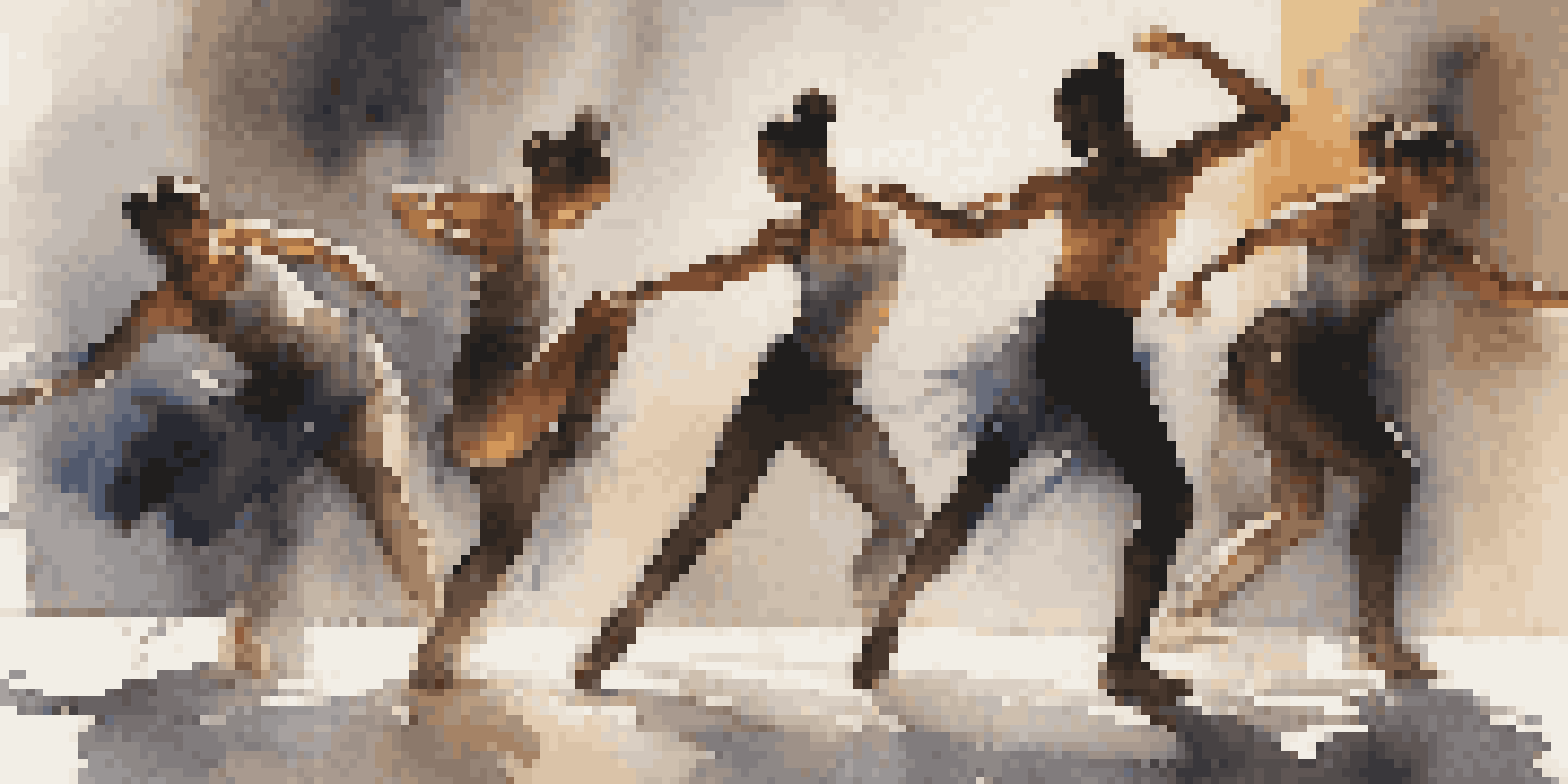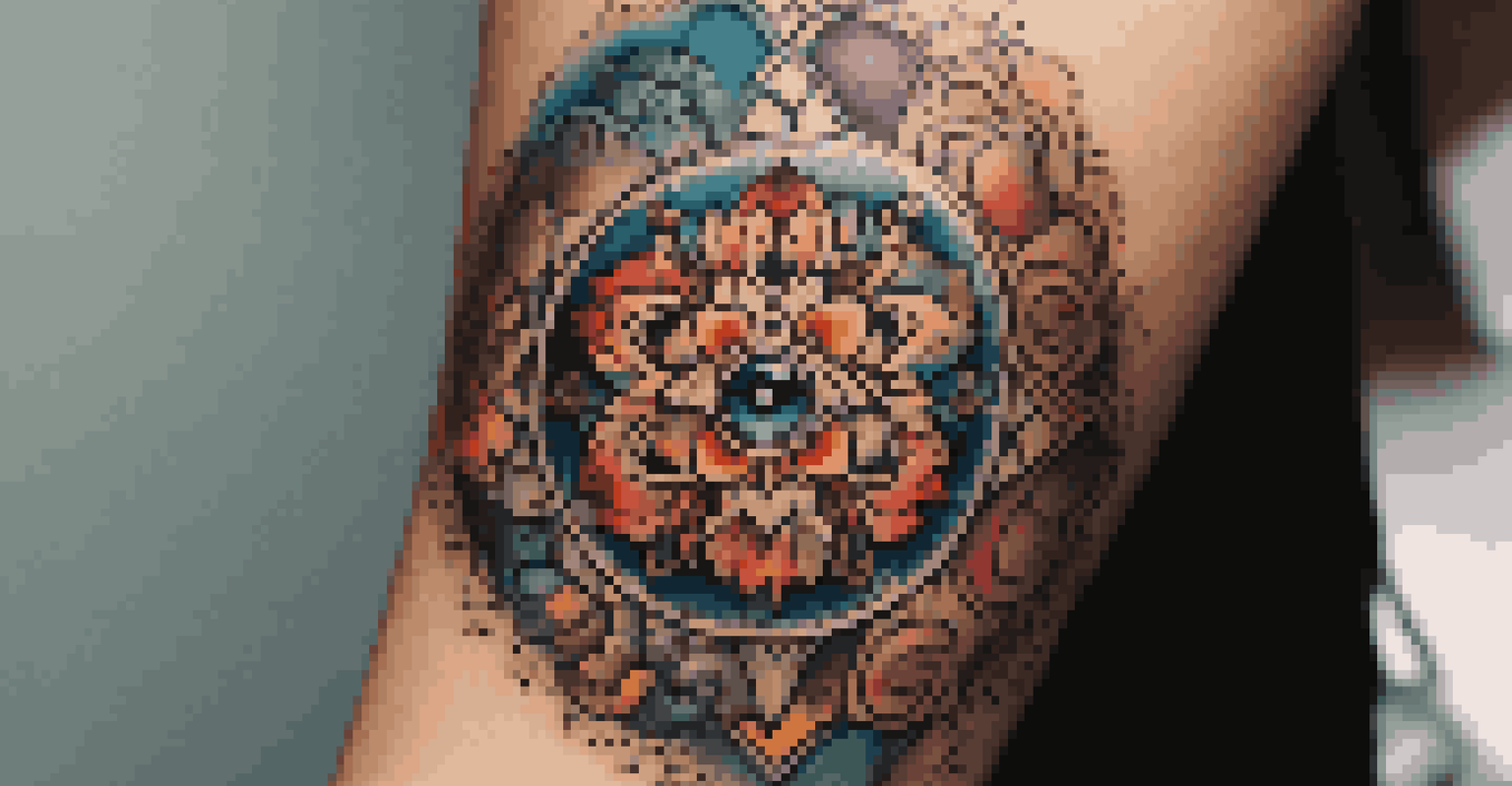Art and the Body: Representations of Human Physicality

The Evolution of Human Representation in Art
Throughout history, artists have depicted the human body in various ways, reflecting cultural values and societal norms. From the idealized forms of ancient Greek sculptures to the raw realism of the Renaissance, each era offers a unique lens into how humanity has viewed itself. For instance, Michelangelo's 'David' showcases the perfection of human anatomy, while contemporary artists often challenge these ideals, embracing imperfections and individuality.
Art enables us to find ourselves and lose ourselves at the same time.
This evolution is not merely about aesthetics; it’s a narrative of how perceptions of beauty and body image have changed over time. In the Middle Ages, for example, religious iconography often portrayed bodies in ways that emphasized spirituality over physicality. Fast forward to today, and we see an explosion of diversity in representations of the body, reflecting broader conversations about identity, race, and gender.
By analyzing these shifts, we can better understand not just art history, but also the cultural currents that shape our views on the body. This ongoing dialogue between art and society reveals much about our collective psyche and the values we hold dear.
The Body as Canvas: Body Art and Its Significance
Body art, including tattoos and body painting, transforms the human form into a living canvas, expressing identity and personal stories. This practice dates back thousands of years, with cultures worldwide using body art to signify status, commemorate events, or showcase beauty. Today, tattoos have become mainstream, often seen as a form of self-expression and empowerment.

However, the significance of body art goes beyond aesthetics. For many, it serves as a reclamation of autonomy over one's own body, especially in societies that impose strict norms about appearance. This can be particularly poignant for marginalized groups, where body art becomes a powerful statement of identity and resistance.
Art Reflects Changing Body Ideals
Throughout history, art has evolved to reflect societal norms and cultural values regarding the human body, showcasing both idealized forms and diverse representations.
As we examine this trend, it becomes clear that body art is a profound form of communication. Each tattoo or design can tell a unique story, inviting viewers to engage with the meanings behind the ink, thus fostering deeper connections between artist, subject, and observer.
Exploring Physicality in Contemporary Dance
Contemporary dance offers a dynamic exploration of human physicality, using movement to convey emotion and narrative. Choreographers often focus on the body’s capacity to express complex ideas, pushing the boundaries of what dance can represent. For instance, companies like Alvin Ailey American Dance Theater highlight the beauty and strength of diverse bodies, celebrating individuality through movement.
The body is a canvas, and it tells the story of your life through every mark and scar.
In contemporary dance, the body is not just a vessel but a powerful tool for storytelling. Dancers embody themes of struggle, joy, and resilience, inviting audiences to experience these emotions viscerally. This connection between performer and viewer creates a shared space where physicality transcends words.
Moreover, the integration of technology in dance performances has opened new avenues for exploring the body. With the use of projections and digital elements, dancers can play with perceptions of space and form, merging the physical with the virtual. This fusion challenges traditional conceptions of the body and expands the possibilities for artistic expression.
Representation of the Body in Photography
Photography has played a pivotal role in shaping perceptions of the human body, capturing its beauty, vulnerability, and diversity. From classic portraiture to modern fashion photography, the lens has the power to either glorify or critique societal standards of beauty. Renowned photographers like Richard Avedon and Annie Leibovitz have used their craft to celebrate the human form in all its complexity.
However, the medium also comes with challenges, particularly regarding how bodies are represented. The rise of social media has led to a surge in edited and curated images, often presenting unrealistic ideals. This phenomenon raises questions about authenticity and the impact of visual culture on body image, especially among young audiences.
Body Art as Personal Expression
Body art, including tattoos, serves as a powerful medium for individuals to express their identities and reclaim autonomy over their bodies.
As we navigate this landscape, it’s essential to recognize the responsibility that comes with representation in photography. By showcasing diverse bodies and authentic stories, photographers can challenge stereotypes and foster a more inclusive understanding of human physicality, paving the way for broader acceptance in society.
Sculpture: Capturing the Essence of Physicality
Sculpture has long been a medium through which artists explore the human form. Whether carved from marble or molded from clay, sculptures provide a three-dimensional representation of the body, allowing viewers to interact with the work from multiple angles. Famous sculptures, like Rodin’s 'The Thinker,' encapsulate not just the physical form but also the emotional depth of the human experience.
Through techniques like exaggeration and abstraction, sculptors can emphasize specific aspects of the body, inviting viewers to reflect on deeper themes such as strength, fragility, and identity. For instance, the works of contemporary artist Marc Quinn push the boundaries of traditional sculpture, using unconventional materials to explore issues of bodily autonomy and the human condition.
Moreover, public sculptures often spark conversations about the bodies they represent in society. They can challenge norms, celebrate diversity, or even critique existing power structures. As such, sculpture serves as a powerful medium for reflecting and shaping cultural attitudes towards the body.
The Impact of Digital Art on Body Representation
Digital art has revolutionized the way we represent the human body, offering new tools and platforms for creative expression. Artists can manipulate images, create virtual installations, and explore concepts of identity in ways that were previously unimaginable. This flexibility allows for a diverse range of interpretations, from hyper-realistic portrayals to surreal representations that challenge our understanding of physicality.
One fascinating aspect of digital art is its accessibility, enabling artists from various backgrounds to share their work globally. This inclusivity fosters a rich tapestry of perspectives on body image, identity, and culture. For example, online platforms like Instagram have become vital spaces for artists to showcase their work, often leading to movements that celebrate body positivity and diversity.
Digital Art Challenges Body Standards
Digital art revolutionizes body representation by offering diverse interpretations while also raising questions about authenticity and societal pressures.
However, the digital realm also poses challenges, particularly in how bodies are often idealized or altered. This raises important questions about authenticity and the pressure to conform to certain standards. As digital artists navigate these complexities, they play a crucial role in shaping contemporary conversations about body representation and self-image.
Art as a Mirror: Reflecting Society's Views on the Body
Art has always served as a mirror to society, reflecting our beliefs, values, and attitudes towards the human body. Whether through classical masterpieces or modern installations, artists often comment on societal norms and expectations. For example, works that challenge conventional beauty standards can provoke critical discussions about body image, health, and identity.
Moreover, art can be a powerful tool for advocacy, raising awareness about issues such as body positivity and mental health. Artists like Jenny Saville have used their work to confront societal pressures surrounding body image, inviting viewers to engage with challenging themes. These conversations are essential in a world where many struggle with self-acceptance and societal expectations.

In exploring these themes, art not only reflects society but also has the potential to inspire change. By challenging preconceived notions about the body, artists encourage audiences to reconsider their own beliefs and foster greater empathy and understanding towards others.